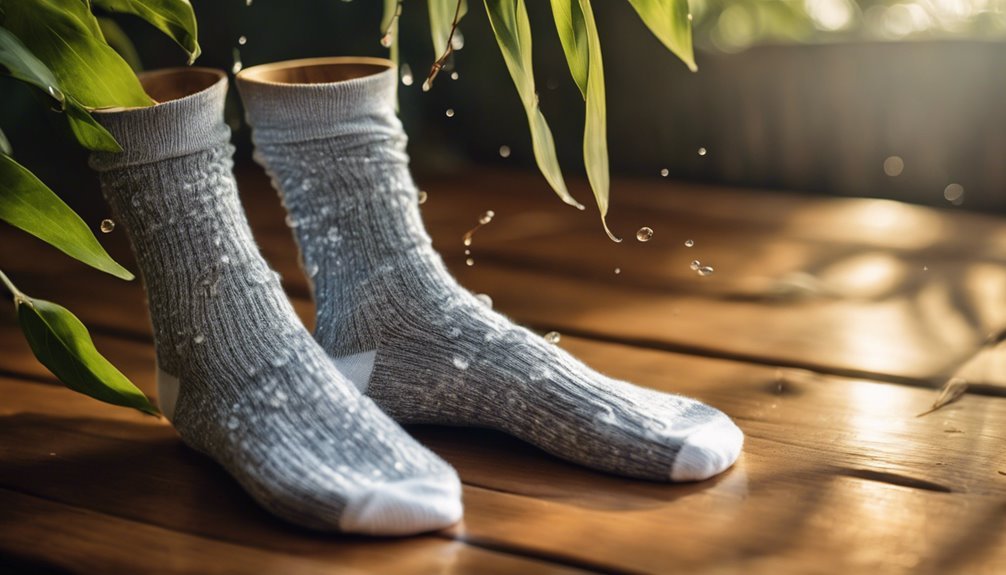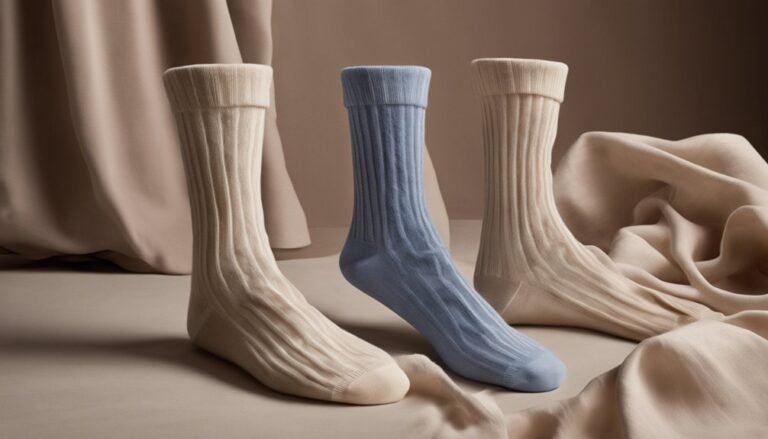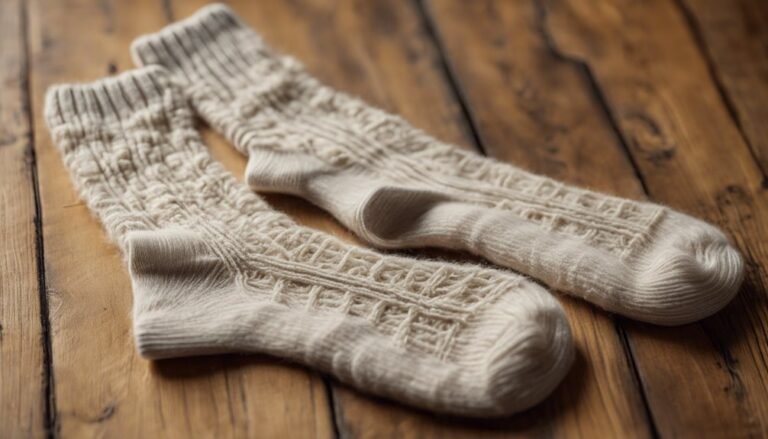Bamboo vs. Polyester Socks: Which Is More Breathable?
When it comes to breathability, bamboo socks outperform polyester socks. Bamboo's natural fibers allow for better airflow and moisture-wicking, keeping your feet dry and comfortable. They also have antibacterial properties that reduce odor. On the other hand, polyester can trap heat and moisture, although it boasts durability and quick-drying capabilities. If you're choosing between the two for breathability, bamboo is the more effective option for maintaining foot health. Discover more about their unique properties below.
Understanding Breathability in Socks

Although many factors contribute to sock comfort, breathability is fundamental for maintaining foot health and overall wearability. Breathability refers to a sock's ability to allow moisture and heat to escape while letting fresh air in. This quality is essential for preventing sweat accumulation, which can lead to odor, discomfort, and even fungal infections. When evaluating sock materials, natural fibers like bamboo and merino wool typically offer superior breathability compared to synthetic options like polyester. These materials have inherent moisture-wicking properties, promoting airflow and keeping your feet dry. In contrast, polyester can trap heat and moisture, leading to a less comfortable experience. Choosing the right materials is critical for achieving ideal breathability and enhancing your overall sock performance.
The Characteristics of Bamboo Socks
Bamboo socks offer several key characteristics that enhance comfort and performance. Their natural moisture-wicking ability keeps your feet dry, while their antibacterial properties help prevent odor. Additionally, bamboo's temperature regulation features guarantee that your feet stay cool in summer and warm in winter, making them a versatile choice for any season.
Natural Moisture Wicking
When it comes to moisture-wicking properties, few materials can compete with bamboo. Its natural moisture-wicking efficiency is one of the standout features that make bamboo socks a popular choice for those seeking comfort and performance. Bamboo fibers have a unique structure that allows them to absorb moisture effectively, keeping your feet dry and comfortable.
- Naturally breathable and lightweight
- High wicking efficiency that draws moisture away
- Helps regulate temperature for peak comfort
This means you can enjoy longer wear without the discomfort of dampness. Whether you're hiking, running, or just lounging around, bamboo socks provide a level of moisture management that polyester often struggles to match. Embrace the freedom of dry feet with bamboo's impressive natural properties.
Antibacterial Properties
How do bamboo socks manage to stay fresher for longer than their synthetic counterparts? The answer lies in their remarkable antibacterial properties. Bamboo fibers contain a natural antibacterial agent known as "bamboo kun," which notably enhances their antibacterial effectiveness. This characteristic helps inhibit the growth of odor-causing bacteria, making bamboo socks less likely to retain unpleasant smells compared to polyester socks. In a fabric comparison, you'll find that while polyester can trap moisture and foster bacterial growth, bamboo remains more hygienic due to its inherent properties. This means that when you choose bamboo socks, you're not just opting for comfort, but also for a cleaner, fresher experience that promotes foot health. Embrace the freedom of freshness with bamboo!
Temperature Regulation
Many people underestimate the importance of temperature regulation in socks, yet it plays a crucial role in overall comfort. Bamboo socks excel in this aspect due to their inherent properties that promote thermal comfort and seasonal suitability. They adapt to varying temperatures, keeping your feet warm in colder months and cool during warmer seasons.
- Naturally moisture-wicking, preventing dampness
- Breathable fibers that enhance airflow
- Insulating properties for ideal warmth
These characteristics allow bamboo socks to manage heat effectively, reducing the risk of overheating or chilling. When you choose bamboo, you're investing in a sock that supports your feet's natural temperature regulation, providing freedom and comfort regardless of the conditions. Embrace the versatility and experience a significant difference!
The Characteristics of Polyester Socks
Polyester socks are known for their durability and moisture-wicking properties, making them a popular choice for active individuals. The polyester fabric excels in moisture management, keeping your feet dry during intense activities. Here's a breakdown of some key characteristics:
| Property | Description | Benefit |
|---|---|---|
| Durability | High resistance to wear | Long-lasting use |
| Moisture Control | Wicks away sweat | Enhanced comfort |
| Quick-drying | Dries rapidly after washing | Convenient maintenance |
| Breathability | Allows some airflow | Reduces odor buildup |
Understanding these characteristics helps you make an informed choice. With their robust performance, polyester socks offer freedom and comfort for those who lead an active lifestyle.
Moisture-Wicking Properties of Bamboo

Although bamboo may not be as commonly discussed as synthetic fibers, its moisture-wicking properties make it an excellent choice for socks. Bamboo fiber is renowned for its ability to absorb moisture, keeping your feet dry and comfortable throughout the day. This natural fiber quickly draws sweat away from your skin, allowing for better breathability.
- Naturally antibacterial, reducing odor
- Soft and gentle on your skin
- Eco-friendly and sustainable option
With high moisture absorption capabilities, bamboo socks are particularly advantageous for active individuals. If you're looking for a sock that works harmoniously with your body's needs, bamboo offers a breathable, comfortable alternative that aligns with your desire for freedom and natural materials.
Moisture-Wicking Properties of Polyester
When you consider moisture-wicking properties, polyester offers distinct advantages due to its hydrophobic fiber characteristics, which repel water and help keep your feet dry. Its quick-drying capabilities guarantee that any moisture is rapidly evaporated, making it ideal for active wear. Additionally, polyester's inherent odor resistance features further enhance its performance by minimizing unpleasant smells during prolonged use.
Hydrophobic Fiber Characteristics
Moisture management is a critical factor in sock performance, particularly in active wear. Polyester's hydrophobic properties make it an excellent choice for moisture-wicking applications. The fibers repel water, preventing the absorption that can lead to discomfort during physical activities.
Consider these key benefits of polyester:
- Quick moisture removal: It actively pulls sweat away from your skin.
- Durability: Polyester fibers resist wear and maintain their shape over time.
- Versatile fiber applications: Ideal for various climates and activities, enhancing your comfort.
Quick-Drying Capabilities
Because polyester fibers effectively wick moisture away from the skin, they play an essential role in quick-drying capabilities. This moisture-wicking action is a key feature of quick dry technology, enhancing drying speed considerably compared to natural fibers. When you're engaged in physical activities, the ability of polyester to draw moisture away guarantees you stay comfortable and dry.
| Feature | Polyester Socks |
|---|---|
| Moisture-Wicking | Excellent |
| Drying Speed | Fast |
| Breathability | Moderate |
| Durability | High |
Odor Resistance Features
The quick-drying capabilities of polyester not only enhance comfort during physical activities but also contribute to its odor resistance features. This synthetic fabric employs advanced odor control mechanisms that prevent the buildup of bacteria, which are primarily responsible for unpleasant smells.
Key aspects of polyester's fabric odor resistance include:
- Moisture-wicking: Quickly draws sweat away from the skin, reducing dampness.
- Breathability: Allows air circulation, minimizing heat and moisture retention.
- Antimicrobial treatments: Some polyester socks are treated to further inhibit bacterial growth.
These factors work together to guarantee that your socks stay fresher for longer, making polyester a worthwhile choice for those valuing both comfort and hygiene in their active lifestyle.
Comfort Levels: Bamboo vs. Polyester
When it comes to comfort, bamboo and polyester socks offer distinct experiences that cater to different preferences. Bamboo socks are often praised for their softness and natural feel, making them ideal for those who prioritize a gentle touch against the skin. They're also moisture-wicking, which can enhance your overall comfort during active wear. In contrast, polyester socks might not provide the same luxurious feel, but they excel in durability and stretch, accommodating various sock styles. If you value resilience and a snug fit, polyester can meet your comfort preferences effectively. Ultimately, your choice will depend on what specific attributes you prioritize in a sock, whether it's plush softness or robust flexibility.
Temperature Regulation: Which Material Performs Better?

When it comes to temperature regulation, both bamboo and polyester socks have distinct characteristics worth considering. Bamboo's moisture-wicking properties and natural breathability promote effective airflow, while polyester offers quick-drying capabilities. Understanding these differences in temperature retention capacity and ventilation can help you choose the right material for your needs.
Moisture-Wicking Properties
While both bamboo and polyester socks are designed to keep your feet comfortable, their moisture-wicking properties vary considerably, impacting temperature regulation. Bamboo fibers excel in moisture absorption, drawing sweat away from your skin and helping to maintain a cooler temperature. In contrast, polyester tends to trap moisture, which can lead to discomfort during prolonged wear.
Consider these points when comparing the fabrics:
- Bamboo's natural antibacterial properties help reduce odor.
- Polyester socks are often more durable and resistant to wear.
- The breathability of bamboo can enhance overall foot comfort.
In this fabric comparison, you'll find that bamboo socks generally outperform polyester in moisture-wicking capabilities, offering a fresher, cooler experience for your feet.
Airflow and Ventilation
The effectiveness of airflow and ventilation in socks plays a significant role in temperature regulation, especially during physical activities. When you consider airflow dynamics, bamboo socks generally offer superior ventilation efficiency compared to polyester. The natural fibers in bamboo create micro-gaps, allowing for enhanced air circulation, which helps wick away heat and moisture. This design keeps your feet cooler and more comfortable during intense workouts. In contrast, polyester tends to trap heat due to its tighter weave, compromising airflow dynamics. Consequently, if you're looking for socks that prioritize breathability and temperature control, bamboo's ventilation efficiency could be your best bet. Ultimately, understanding these differences can empower you to make informed choices about your sock preferences.
Temperature Retention Capacity
Although both bamboo and polyester socks offer distinct advantages, their temperature retention capacity diverges significantly. Bamboo socks excel in managing temperature fluctuations due to their natural insulation properties, allowing for better moisture absorption and maintaining a comfortable foot environment. Conversely, polyester socks tend to trap heat, which can lead to discomfort in warm conditions.
Consider these points when choosing your socks:
- Bamboo: Naturally breathable, excellent moisture-wicking.
- Polyester: Durable, retains warmth in cooler temperatures.
- Performance: Choose based on your activity level and climate.
Ultimately, if you're after a sock that regulates temperature effectively, bamboo may be your best bet. However, for colder climates, polyester's insulation properties might serve you better.
Durability and Longevity of Each Material
When considering the durability and longevity of bamboo and polyester socks, it's essential to recognize that each material has distinct properties impacting its lifespan. Bamboo socks generally resist wear and tear due to their natural fibers, offering a softer feel that can withstand frequent use. However, they may not hold up as well under rigorous washing conditions compared to polyester. On the other hand, polyester socks boast excellent resilience and are engineered for durability, often lasting longer through heavy wear. In a lifespan comparison, polyester typically outperforms bamboo regarding longevity, particularly for active lifestyles. Ultimately, your choice may depend on how you prioritize comfort versus durability, helping you select the right sock for your needs.
Environmental Impact of Bamboo and Polyester Socks
While bamboo is often lauded for its eco-friendly properties, the environmental impact of bamboo and polyester socks warrants careful examination. Bamboo socks can be produced through eco-friendly sourcing, leveraging renewable resources and sustainable forestry practices. However, the manufacturing process may involve chemicals that can negate some of these benefits.
On the other hand, polyester socks are derived from petroleum, a non-renewable resource, and their production typically involves high energy consumption and emissions.
Consider these key points:
- Bamboo socks often require less water and land.
- Polyester production is linked to plastic pollution.
- Both materials can be recycled, but bamboo fibers are biodegradable.
Ultimately, understanding these factors can guide you in making informed choices aligned with sustainability practices.
Choosing the Right Socks for Your Activities
How do you choose the right socks for your specific activities? First, consider the sock activities you'll engage in—running, hiking, or lounging all require different features. For high-performance sports, prioritize moisture-wicking materials like bamboo or polyester, which enhance breathability and reduce blisters. Evaluate cushioning and support; thicker socks may offer more comfort for long treks, while lightweight options are ideal for speed. Performance considerations also include fit; socks should hug your feet without constriction. Finally, think about climate; bamboo excels in warm conditions, while polyester can provide insulation in cooler environments. By aligning sock features with your activities, you guarantee maximum comfort and performance, allowing you to focus on what matters most—your freedom to move.
Frequently Asked Questions
Can Bamboo Socks Cause Allergic Reactions in Sensitive Individuals?
Imagine a world where bamboo socks trigger allergic reactions—it's not far-fetched! Individuals with bamboo allergies might experience sensitivity reactions, including rashes or irritation. Always test a small area before fully committing to bamboo products.
How Do Bamboo and Polyester Socks Compare in Terms of Odor Control?
When comparing odor control, bamboo properties naturally resist bacteria and odors, while polyester benefits from moisture-wicking abilities. Consequently, bamboo socks may offer better odor management, particularly for prolonged wear during active use.
Are There Specific Activities Better Suited for Bamboo or Polyester Socks?
When considering activities, bamboo socks excel in casual, warm environments due to their moisture-wicking properties. In contrast, polyester socks perform better in high-intensity sports, offering durability and support for rigorous movement. Choose based on your needs.
Do Bamboo Socks Require Special Washing Instructions?
While you might think all socks are alike, bamboo socks do need careful washing techniques. They require gentle fabric care, unlike sturdier materials. Washing them in cold water preserves their softness and extends their lifespan.
How Do the Costs of Bamboo and Polyester Socks Compare?
When comparing costs, bamboo socks often reflect sustainability factors, potentially leading to higher prices. Polyester socks typically have broader market availability, making them more accessible and affordable, but may compromise on eco-friendliness.







